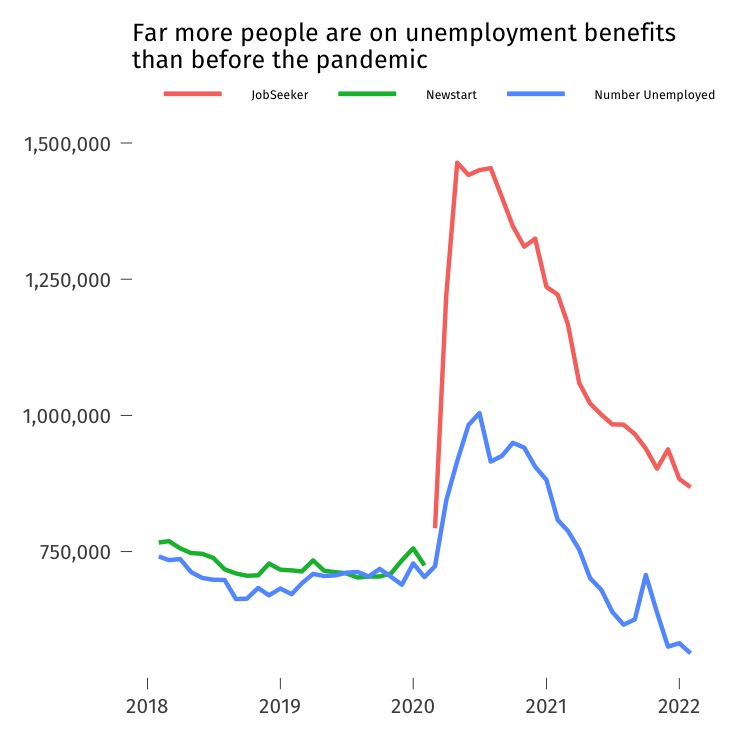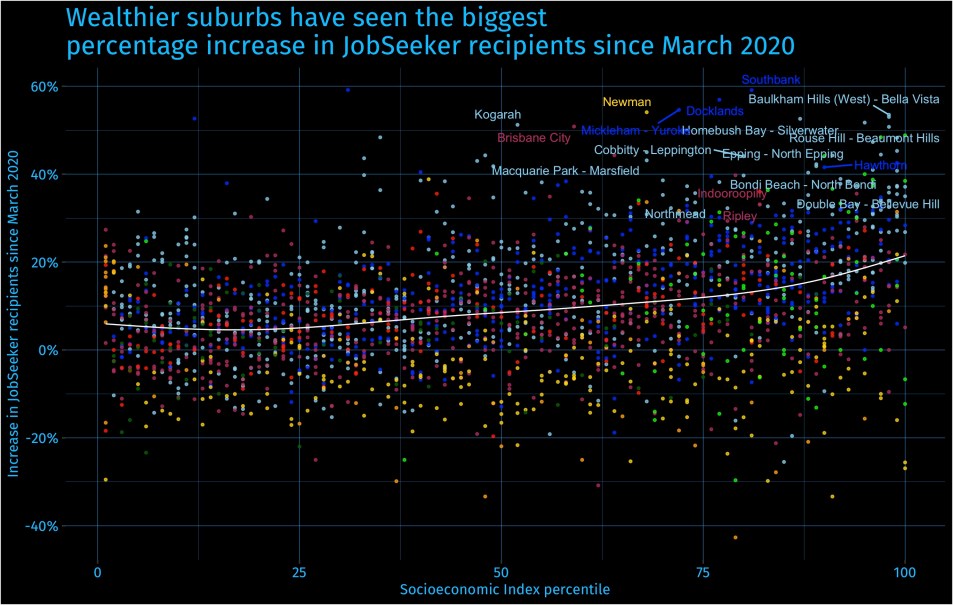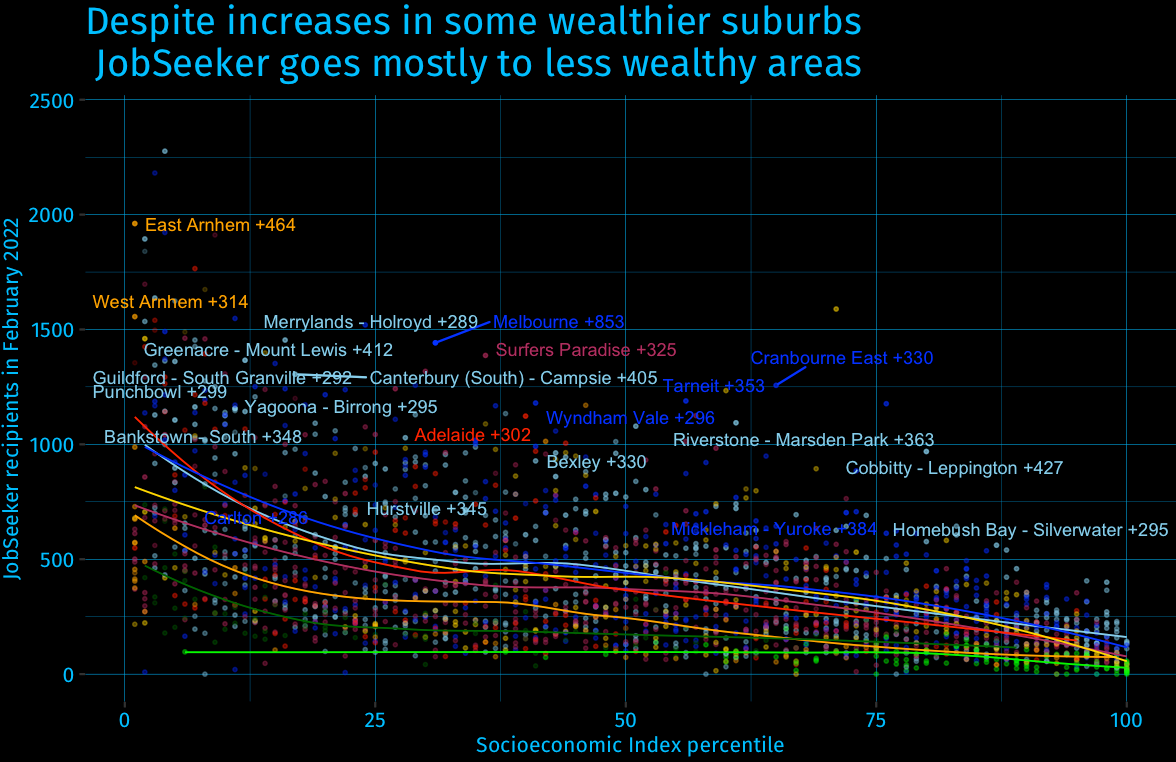
Editor’s note: Jason Murphy has reconsidered this article and while it remains below in its original state, he would love you to read his apology as well.
A curious phenomenon: a government campaigning on its economic record is also paying the dole to more people than any government in history.
And the people it is going to may surprise you.
The unemployment rate has fallen to 4%, the lowest in many, many years. Signs saying “Staff wanted” are in every shopfront on the high street. And yet Centrelink is busier than ever, paying out unemployment benefits to hundreds of thousands of people.
The next graph tells the story. When JobSeeker was invented in the early days of the pandemic, people flocked to sign up. At one point about 1.5 million were on the dole, nearly double the number on Newstart. And not all of them have left the system.

Why the big jump? The answer is not just that unemployment soared. After all, in the chart above, the red line rises far more than the blue line. The answer is much more interesting and it comes in three parts.
- JobSeeker’s eligibility was made much wider. “Mutual obligation” was chucked in the bin. You no longer had to bother looking for a job to receive the payments. The asset test was waived too, so people with more than $470,000 were eligible. Waiting periods were reduced to zero. You wanted the payment today, you got it today.
- The payment became far larger. A coronavirus supplement of $550 was added to the base rate of JobSeeker, effectively doubling it.
- Much more was done over the phone and the internet, with less need to haunt a Centrelink office.
If this was a “nudge” then it was the biggest one ever. Suddenly everyone was signing up for JobSeeker. Young and old, rich and poor. People who had never given Centrelink a thought suddenly realised that for $1000 a fortnight it was worth signing up.
Now those special rules are over, but capable people are still collecting their payments.
Consider Toorak, Melbourne’s wealthiest suburb. It had 114 people on JobSeeker in March 2020, but had 162 in February 2022.
This pattern holds across the country (with the exception of Western Australia). Wealthy suburbs have woken up to the charms of JobSeeker, as the next chart shows. The number of dole recipients is up about 20%. This is off a lower base, admittedly, but the absolute numbers are large in some cases.

There are 93 suburbs that make up the top 5% wealthiest in the nation. Just eight have fewer JobSeeker recipients today than they did in March 2020, with the few meagre falls found mostly in the northern suburbs of Perth. The remaining 85 wealthy suburbs have far more JobSeeker recipients. The biggest rises are in Rouse Hill and Baulkham Hills, in Sydney’s north-west.
At the other end of the distribution, of the 84 suburbs in the poorest 5%, 22 have fewer JobSeeker recipients than before and 62 have more.
No wonder Anthony Albanese has dumped Labor’s policy to increase JobSeeker — it’s clear there has been a shift towards middle- and upper-class welfare during the pandemic.
This is surprising. The kind of jobs wealthy people have are less likely to be affected by the pandemic and lockdowns. Financial markets are roaring, people are working from home — what possible need do the wealthy have for being on the dole?
You could reach for a number of explanations. Perhaps Centrelink is going a bit easier on people as the Coalition is suddenly afraid to dump their own voters off the dole?
Another explanation is that in these suburbs there were always some people who were eligible for JobSeeker but, with other sources of support, never had the impetus to bother learning how to wrangle Centrelink. In the pandemic, with little else to do, they signed up and will collect their payments henceforth. The idea being that the administrative hassle of dealing with Centrelink is not worth it for people who place a high value on their time.
Labor’s decision not to raise JobSeeker is not going to bother these people too badly. But let’s not forget that it hits much harder at the other end of the spectrum. As the next chart shows, JobSeeker recipients are much more likely to live in poorer parts of the country, not richer ones.

Strange times indeed.








This pisses me off. I was unemployed during COVID when the project I was working on was shut down. I registered for benefits but never received anything. I lived off my savings for 10 months until I started working again. Multiple calls to centrelink went unanswered.
@Andrew Lindsay
I deal with Services Australia, the privatized payment section of Medicare, as well as “Home Affairs” department.
Services Australia are “difficult to deal with” and the quickest way to get a drink out of them would be by putting their fingers down their throats.
Did you by any chance keep all the paperwork submitted?
Hopefully you did, because, once this election is over, you may need to do the same thing as I have done on numerous occasions.
Take all the documentation to your local sitting member and get them to fight your side.
It has never failed for me, although sometimes it takes the MP 2 or 3 goes before they pay up at least some of what they owe.
Having a career in IT, family members having to deal with Centrelink, soon started asking for advice.
For a start don’t bother trying to call, when you finally do get through, you inevitably get transferred all over the place, each time taking forever and having to explain yourself Every Single Time! I’ve tried to help filling online forms, again you get shunted from one place to another, each time having to put in a name and password sometimes being told that you could have used an ID code? and sometimes being asked for a messaged code. And when you finally get to the correct online forms some of the questioning regarding various claims or circumstances or situations were just incomprehensible.
It’s almost designed for you to fail, in which case you inevitably not only waste time but have to actually front up to a Centrelink centre. I accompanied one family member last year and after a two hour wait fronted up mad as a cut snake to the poor hapless guy sitting opposite us at his computer. I realised that these people had to deal with us day in day out, having to negotiate the same p*ss poor software we had to deal with at home.
I don’t know if people who deal with them continually just get used to it or get to know all the pitfalls or just forget about trying to second guess the system and front up to centre every time, but talk about a system designed by a committee…
Yes, Bref, it’s all that, and worse. The system is designed to demean and short-change. And while Centrelink can demand repayment of over-payments years later (eg Robodebt), they don’t have to repay underpayments after 13 weeks. Because the system is so complicated, it often takes > 13 weeks for the applicant to realise they’ve been short-changed, if they ever do.
And the system stuffs up about 50% of actions in my experience. That’s one reason people on JobSeeker are reluctant to take short-term casual jobs – they can’t afford to have their below poverty-line payments delayed through stuff-ups when the short-term job dries up.
A Welfare Rights Centre report years ago concluded that to have a reasonable chance of getting their entitlements, applicants had to know more about how the system worked than the people working in Centrelink.
Now the Crikey bot has embargoed my reply. I’ll try again:
Yes, Bref, it’s all that, and worse. The system is designed to demean and short-change. And while Centrelink can demand repayment of over-payments years later (eg Robodebt), they don’t have to repay underpayments after 13 weeks. Because the system is so complicated, it often takes > 13 weeks for the applicant to realise they’ve been short-changed, if they ever do.
And the system makes mistakes about 50% of the time in my experience. That’s one reason people on JobSeeker are reluctant to take short-term casual jobs – they have no savings and can’t afford to have their below poverty-line payments delayed through Centrelink mistakes when the short-term job dries up.
A Welfare Rights Centre report years ago concluded that to have a reasonable chance of getting their entitlements, applicants had to know more about how the system worked than the people working in Centrelink.
Yes, Bref it is supposed to be nigh on impossible to navigate and incredibly difficult if someone speaks english as a second language.
The people you are dealing with in both the Center Link office and by phone are given a bonus for every claimant they can either delay or dismiss as ineligible.
Does this explain the “run around?”
I used to be on Newstart (Incapacitated stream) and yes, if I ever ran into trouble I just went straight into the office. Don’t even bother ringing. The best time to go in is about 90-60 minutes before it closes. I usually only had to wait 15-30 minutes in the queue.
It is interesting to see that so many of the wealthy Sydney suburbs mentioned here are also well within the born-again bible belt – Jobseeker as a subsidy for Hillsong?
I would suggest it is the sons and daughters of the rich, unable for two years to take their gap year frolics across Europe, and not particularly keen to start their uni studies, especially online. Just as their presence in the Covid-entrapped labour market prompted the increased largesse and relaxed rules in the first instance. Can’t have our own bright young things experiencing poverty and, even less, subjected to the punishment regime reserved for Pru Goward’s underclass.
Confused ‘When JobSeeker was invented in the early days of the pandemic…’ shouldn’t it be ‘JobKeeper’ as JobSeeker remains after being preceded by NewStart?
Nonetheless, many east suburban middle class have kids who also can be unemployed and same suburbs e.g. even Toorak, have significant apt. rentals, where many may be on lower income.
@Drew
Job Seeker and Job Keeper were invented at the same time to blur the differentiation between the two subsidies.
Job Keeper was the program where the companies employing lots or not so many people got the money which they were supposed to use it to pay the wages of their staff, or a percentage of it.
Job Keeper had no “Claw back clauses” and so, the really large companies took the money passed on as little as they like and kept the money. Job Keeper was wound up as soon as the heavy lockdowns ended. The large companies (Cartier, Nick Scali, Harvey Norman and all of those got subsidies whilst their profits were soaring. Most of them shuffled a bit and most did not pay back any money. Bonuses for the executives and higher shareholder dividends.
Job Seeker is a different kettle of fish.
It is a rebadged New Start, that was given a temporary increase (Covid supplement), which effectively brought it up to just under the poverty line. That was the first measure snatched back and Joshie from Toorak wrote a claw back clause into this legislation.
No Food Delivery cyclist or scooter driver is ever going to keep the extra $10 they may have made working that 80 hour week with a zero dollar contract.